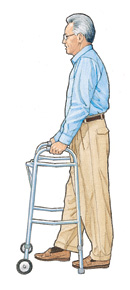Walker Use

A walker with 4 solid prongs on the bottom (no wheels) is one of the most stable mobile aids or assistive devices. It lets you take some of the weight off your legs as you walk. To use it, though, you have to be able to lift it off the ground to move it forward. Other walkers may have 2 wheels in front (see picture), or 4 wheels. A walker with wheels allows you to push it forward without lifting it off the ground.
Walker height
Adjust your walker so that the top of the walker (where you hold on) is level with the crease in your wrist when you stand up straight. With your hands on the walker, your elbow should bend about 20 to 30 degrees.
Walker use
The following are general use guidelines:
-
First, put your walker about one step or a few inches ahead of you.
-
Make sure that all 4 prongs or wheels are on the ground before taking a step forward or backward.
-
Look where you are going, not at your feet.
-
Grip the top of the walker with both hands for support.
-
Lift your injured or weakest leg and step into the walker frame. Don’t step all the way to the front bar of your walker.
-
Complete your step by bringing your good leg forward.
-
Take small steps when you turn.
-
To sit, back up until your legs touch the chair. Reach back to feel the seat before you sit.
-
To get up from a chair, place the walker in front of you. Push yourself up by pressing down on the arms of the chair. As you shift your weight onto your feet, move one hand at a time to your walker. Don't use a walker to climb stairs or to use an escalator.
Safety tips
These tips will help you safely use your walker:
-
Make sure that all 4 prongs or wheels are on the ground before moving yourself forward or backward.
-
In the home, remove scatter rugs, electrical cords, spills, and anything else that might cause you to fall.
-
In the bathroom, use nonslip bathmats, grab bars, a raised toilet seat, and a shower or tub seat.
-
Use a backpack, fanny pack, apron, or briefcase to help you carry things around. To carry lightweight items, you may attach a small pack to the crossbar of the walker.
-
Be sure your shoes fit properly, have nonslip bottoms, and are in good condition.
-
Be cautious when going up and down curbs and walking on uneven sidewalks.
Online Medical Reviewer:
Sabrina Felson MD
Online Medical Reviewer:
Stacey Wojcik MBA BSN RN
Online Medical Reviewer:
Thomas N Joseph MD
Date Last Reviewed:
12/1/2022
© 2000-2024 The StayWell Company, LLC. All rights reserved. This information is not intended as a substitute for professional medical care. Always follow your healthcare professional's instructions.